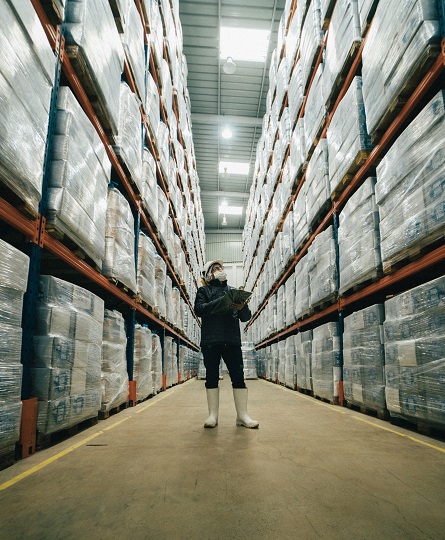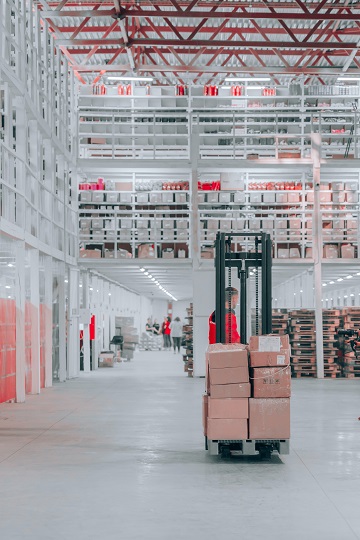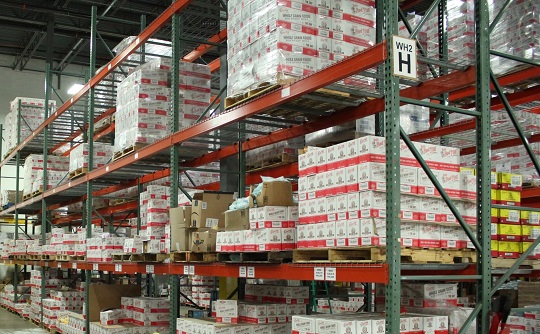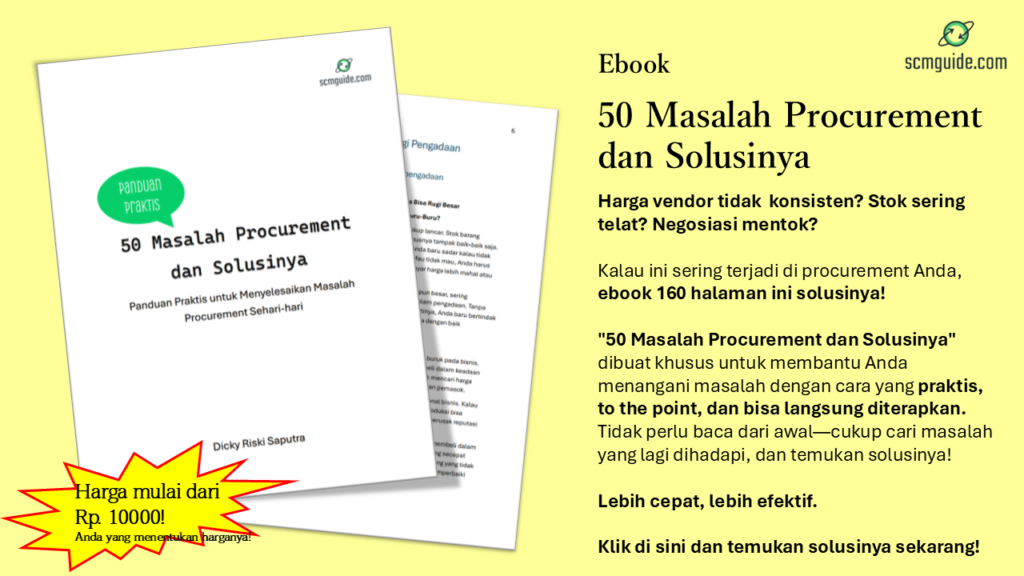Table of Contents
What is warehouse logistics?
Logistics in the warehouse are an important part of any supply chain.
When goods are not being moved from one place to another, they are kept in a warehouse.
The goods will be stored, received, and sent out of the warehouse within a certain amount of time.
Learning about warehouse logistics is one of the most important things you can do to make the most of your warehouse space.
We’ll talk a lot about warehouse logistics, its problems, and how you can make a warehouse plan for your business in this post.
But before we do that, you should also join the scmguide telegram channel to get more insight about supply chain management.
Supply chain vs. logistics
It might seem like these two words mean the same thing. So, let’s talk about what the differences are.
The supply chain is the whole process of turning raw materials into finished goods and getting them to customers.
Logistics, on the other hand, is the detailed planning and execution of complex operations that help you move goods, whether they are physical products or services, through the entire supply chain.
Logistics is the study of things like how racks and bins are used to store goods in warehouses.
Racks are tall places to store things that you can usually find in warehouses. Bins are where you put things on racks.
By putting things on racks and in bins, you can save space on the floor and make it easier for your warehouse staff to find things.
Warehouse logistics
Warehouse logistics is the flow of products when they are being received and sent out, as well as the data that goes along with these flows, such as order fulfillment times or information about the products.

When a product gets to the warehouse, it has to be put in temporary storage until there is a place to store it.
When a sales order comes in, the goods must be found in the warehouse and sent to the customer. This is how things get from one place to another.
Information flow is about figuring out how long it will take to fill a customer’s order based on how much demand there is for a product.
When the two flows work well together, it helps the business run smoothly.
Before work on the warehouse began:
- Set up your warehouse in the right place by thinking about how much it will cost to get goods there and which areas are most in demand.
- Make sure you have enough money to build the warehouse and keep it running.
- Make sure your floor plan is well thought out so you can work well, store more things, and avoid accidents. For instance, area for loading and unloading must be near the highway.
- To do the work in the warehouse, you should hire professionals.
- Make sure the warehouse has all the tools and supplies it needs.
After you’ve set up your warehouse:
- Find out how much it costs to run each day and plan for it.
- Look at the trends and forecasts for your finished product to see if it can meet customer needs.
- Make sure that the software you use to run your warehouse is the right one.
- Make a plan for how to handle broken products and customer returns.
- Implement pest control measures to protect your products.
- Have a safety plan that will help prevent accidents and be ready in case something does go wrong.
Distribution centers and warehouses
Any building that stores things is a warehouse, no matter what the reason is.
On the other hand, a distribution center is a type of warehouse where orders are filled so that they can be sent to other businesses or consumers.
So, distribution centers need to be set up so that items can be quickly found, packed, shipped, and stored in small amounts.
You might also like:
- 4 Reasons Not to Work Too Diligently in Supply Chain Management
- 8 Important Things to Keep in Mind When Running a Container Yard
Why is warehousing important?
Most businesses that sell physical products need warehouses as part of their supply chain.
This could be a consumer business that stores products that will eventually be shipped to retail customers, or it could be a Business to Business (B2B) company that stores products that will eventually be shipped to business customers.

Warehouses allow retail and e-commerce businesses to buy wholesale items in large quantities that might not fit in a store but can still be sold online.
When these businesses buy in bulk, they can talk to their suppliers about lower prices, which helps them make more money when they sell the product to their customers. They can also keep products in stock to make sure they are always available when demand changes.
Also, warehousing lets businesses store products in good locations to save money and cut down on delivery times.
For example, if a business sells products directly to customers all over the country, they may need to keep stock in more than one part of the country.
Also, if they wanted to sell products to people all over the world, they would need to strategically place warehouses in different countries to speed up deliveries and cut down on the number of shipments that had to go through customs.
People today are used to getting their goods the same day they order them, so this is becoming more and more important for businesses that ship directly to their customers.
What does the warehouse hold?
In the warehouse, the most important things to do are:
- Receive goods.
- Look over the goods.
- Moving things around inside the warehouse (between different sections).
- Store and keep items safe.
- Make orders and keep track of work.
- Deliver goods.
- General information management and processing about stock, workflow, demand, etc.
What kinds of things make up the warehouse?
There are a few things to think about when making plans for a warehouse building.
The most important are the products that will be stored, the flow of materials or goods, the space available to store them, the storage equipment (like racks and material handling equipment), the human factors (the people who work there), and the company’s management systems and policies.
You need to find out the following information, which will affect different parts of the facility. So, if you want to build a warehouse, you should think about this.
What needs to be thought about when warehousing?
Even though warehousing seems easy because it mostly involves storing goods, there are steps that need to be taken to make sure it is done well and stock can be moved in and out quickly.
Let’s see.
Capacity planning
The most important thing is space to store things.
So, when a shipment is about to happen, the warehouse staff needs to plan where the products will be stored to make the best use of the space.
Receive inbound material
When the product gets to the warehouse, workers have to pick it up and move it carefully to where it will be stored and processed.
Keep track of stock
As goods come into and go out of the warehouse, they need to be recorded in the warehouse’s Inventory Management System. This way, warehouse managers can keep track of what’s in stock and plan for changes that might happen in the future.
Keeping products
Once the product has been brought in and received, it needs to be put away.
This can be done by putting the product in bins and on pallets and then using material handling equipment to move it to a place where it can be stored.
Keeping the temperature right
Depending on the product, it may be important to keep things like temperature, humidity, or pressure at the same level.
Items that need to be frozen, for example, should be kept in a place where the temperature is below freezing.
To make sure that the goods are of good quality, these rules will determine how and where they are stored in the warehouse.
Reorganization
When new products come in, the old ones may need to be moved to make the most of the space in the warehouse.
Any changes that happen need to be reflected in the Inventory Management System.
Pick up and deliver goods
Lastly, when a product needs to leave the warehouse to be shipped, the warehouse staff must pick it up, process it, package it, load it, and then remove it from inventory to make room for a new product to arrive.
You might also like:
- 9 of the Most Common Reasons Why You Might Have Excess Stock
- 10 Ways to Reduce Supply Chain Costs by a Huge amount
How warehouses make money for businesses
A warehouse can help a business make money in at least three ways.
The first is to keep extra stock on hand as a safety net to prepare for changes in supply and demand.
This is an important part of a business’s good customer service.
When customers are happy, they buy from you again. This means you spend less on advertising and make more money.

The second is to hold on to stock to invest in it. For example, the price of a commodity like coffee can change around the world, and stock can be kept to sell when the price is right.
When that much inventory builds up, it usually can’t be kept in a distribution center. Instead, it needs to be kept in a special warehouse.
Third, warehouses help organizations make the best use of their money and people in manufacturing units and with suppliers. It keeps overtime costs down and lets businesses buy and store more inventory when prices from suppliers are better.
This is the main reason why companies use warehouses or “distribution centers” to fill orders. There are, however, many other kinds of warehouses that can be part of a supply chain.
Other types of warehouse
Some companies have production warehouses in addition to distribution center warehouses. These warehouses are only used to keep the flow of materials that go into the manufacturing process in sync. In some fields, goods are also stored in warehouses.
Unlike warehouses that fill orders, storage warehouses usually don’t do anything that adds value. As the name suggests, the warehouse is only used to store things, and often for a long time.
Stock is sometimes moved and stored all at once in storage warehouses. Lastly, the stock will be sent (maybe all at once) to a more flexible warehouse where it will become part of the supply chain.
Problems that often happen in a warehouse and how to fix them
Some of the most common problems with warehouse logistics have to do with:
- Warehouse layout.
- Ability to find items.
- Damage handling.
- Amount of stock held.
- Communication.
- Time management.
For example, if a broken item isn’t found and taken out of the warehouse, it will take up space that could be used to store other, better items.

This problem will always be a part of warehouse logistics, but every day, new ways to solve it are found. Your business will benefit a lot from keeping up with the latest ways to improve warehouse logistics.
For instance, it’s important to use the right tools to keep an eye on warehouse data and collect it. Let’s say you’re looking for something in the warehouse. If the warehouse is big, you can’t just wander around looking for this thing.
With software, you can quickly find what you are looking for.
Most problems in your warehouse can be fixed by knowing what they are and how to set up a good Warehouse Management System.
The logistics of a warehouse will only work as well as the data that is gathered.
Set up a system that works and hire people who can use it.
Make sure your data is always up-to-date as well.
Pros of a well-thought-out logistics plan for a warehouse
Here are some ways that a good warehouse logistics strategy that is easy to understand can help your business:
- Improved overall efficiency.
- Better inventory management.
- Accurate delivery times and reorder rates.
- Lower operating costs.
- Higher customer satisfaction.
If you have a good plan for how to move things around in your warehouse, your supply chain will work better. As a business owner, this will save you money, and your customers will save money and time.
Conclusion
It is the right thing to do to give your customers the best product you can at the lowest price you can. A big part of this idea is the logistics of the warehouse.
If you have better logistics, your supply chain will work better and both you and your customers will pay less.
Make a list of the issues that affect how your warehouse works and a plan for how to fix them.
One way to solve your warehouse logistics problem is to use WMS to track this activity and put all the data in one place.
Hope it helps!
You should also tell your other coworkers about this article so that they can get the same benefits as you. Join the scmguide Telegram channel to learn more about how to manage supply chains. You can use any of the articles on this blog for whatever you want, including making money off of them. You don’t have to give credit.

 by
by 



